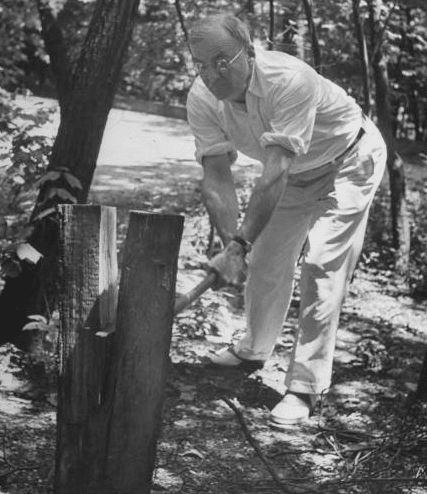I need to buy an axe this weekend so I can do this since I have 3 piles of wood in my yard waiting for me.
From the AOM Blog:
Posted: 24 Nov 2009 03:10 PM PST

Editor’s note: This is a guest post from Will which originally appeared in the Art of Manliness Community.
I’ll admit it: for me, splitting wood has nothing do with lowering the heating bill. I like that satisfying thunk! and the feeling of power, seeing that big obstinate piece of wood doing what I want. The look of the fire in the evening is nice, too, especially when you didn’t have to buy the wood at the supermarket.
Here’s how to harness your inner-lumberjack and hew some firewood with your own manly hands.
What You Need
A maul or ax. A maul is heaver and has a wider head than an ax which makes it advantageous to splitting wood. But an ax can work just as well for smaller wood splitting jobs. Also, remember that the key isn’t sharpness; you’re not cutting wood or even chopping it (a common misnomer); you’re splitting wood.
Wood. Seasoned wood splits better, but I usually split the wood green, so I don’t have to stack it again.
 If the wood has nails in it, forget it. It’s not worth the risk of damaging your ax, or for that matter your eye when that nail goes flying. And if it’s curvy, don’t bother. I’m no safety expert, but trying to deal with unusual situations is often how accidents happen.
If the wood has nails in it, forget it. It’s not worth the risk of damaging your ax, or for that matter your eye when that nail goes flying. And if it’s curvy, don’t bother. I’m no safety expert, but trying to deal with unusual situations is often how accidents happen.
If it’s got a knot in it, skip it, especially if it’s green. You’ll spend all day trying to get through it. The exception is if you can find a line through the center that doesn’t get close to any knot. Then the knots won’t interfere. (”Center” is defined by the grain or splits in the wood, as shown on the right.)
Split It Along the Lines
Put the piece on its end, on a chopping block if possible. If not, just put it on the ground, propping it as needed to keep it standing. Driving the ax into the ground dulls it, supposedly, but I’ve chopped into dirt countless times and the ax still cuts.
Now place yourself such that when you swing with straight arms, the blade will hit the wood, right in the center (picture on left). Err on the side closer to you. Here’s why: if you miss on the side close to you, the blade goes into the ground. But if you miss on the far side, the ax handle hits the wood. Too much of that and you’ll be buying a new handle. (It hurts your arms too.)
Making sure there’s no one and nothing you don’t want damaged anywhere nearby, to be hit by flying wood, a flying ax, or anything else . . . stand with your legs apart a little, pull the ax straight back over your head, and swing it straight forward. Build up speed and let the momentum and weight of the ax do the work– not your brute strength.
I try to hit the same place every time. I never do. It doesn’t matter. Wood with a slightly ragged edge is not a problem. You will get the ax stuck in the wood and have to wrestle it out (right); that’s also not a problem.
Eventually it will split with a nice crack! Then do a few gentle hits into the crack to separate remaining strands of wood connecting the pieces of wood together.
If the piece is bigger, you can still go for the center, but it might be easier to chop pieces off the sides, until you have something manageable.
What You Get
Those pieces that you made too small . . . are your best accomplishment, because they’ll help you start the fire. Split wood burns more easily, especially the small pieces.
And now that you have a woodpile full of fuel . . . it’s time to make a fire.
No comments:
Post a Comment